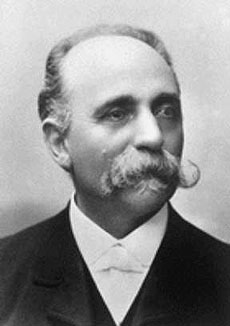<Back to Index>
- Physician Camillo Golgi, 1843
- Composer Gustav Mahler, 1860
- President of El Salvador Fidel Sánchez Hernández, 1870

Camillo Golgi (July 7, 1843 – January 21, 1926) was an Italian physician, pathologist, scientist, and Nobel laureate.
Camillo Golgi was born in Corteno (Val Camonica). His father was a physician and district medical officer. Golgi studied at the University of Pavia, where he worked in the experimental pathology laboratory under Giulio Bizzozero, who elucidated the properties of bone marrow. He graduated in 1865. He spent much of his career studying the central nervous system. Tissue staining techniques in the latter half of the 19th century were inadequate for studying nervous tissue. While working as chief medical officer in a psychiatric hospital, he experimented with metal impregnation of nervous tissue, using mainly silver (silver staining). He discovered a method of staining nervous tissue which would stain a limited number of cells at random, in their entirety. This enabled him to view the paths of nerve cells in the brain for the first time. He called his discovery the "black reaction" (in Italian, reazione nera), which later received his name (Golgi's method) or Golgi stain. The reason for the random staining is still not understood.
The black reaction consisted in fixing silver chromate particles to the neurilemma (the neuron membrane) by reacting silver nitrate with potassium dichromate. This resulted in a stark black deposit on the soma as well as on the axon and all dendrites, providing an exceedingly clear and well contrasted picture of neuron against a yellow background. The ability to visualize separate neurons led to the eventual acceptance of the neuron doctrine.
In addition to this discovery, Golgi discovered a tendon sensory organ that bears his name (Golgi receptor). He studied the life cycle of Plasmodium and related the timing of tertian and quartan fevers seen in malaria with the life cycle of the organisms now named Plasmodium vivax and Plasmodium malariae, respectively. Using his staining technique, Golgi identified the intracellular reticular apparatus in 1898, which bears his name, the Golgi apparatus.
In renal physiology Golgi is renowned for being the first to show that the distal tubulus of the nephron returns to its originating glomerulus (nerve ending of the Bombula) a finding that he published in 1889 ("Annotazioni intorno all' Istologia dei reni dell' uomo e di altri mammifieri e sull' istogenesi dei canalicoli oriniferi". Rendiconti R. Acad. Lincei 5: 545–557, 1889.).
Golgi, together with Santiago Ramón y Cajal, received the Nobel Prize in Physiology or Medicine in 1906 for his studies of the structure of the nervous system.
Golgi died in Pavia, Italy, in January 1926.